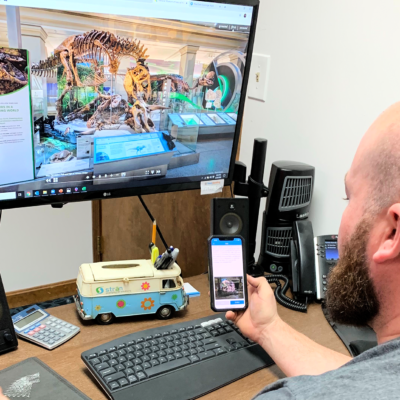We’ve outlined five steps for starting and managing a remote team with a focus on building culture.
No longer a special arrangement for a handful of team members, remote work has become more common than ever. Today, the impact of the coronavirus (COVID-19) has imposed work from home mandates, and many companies need to start and manage remote teams, fast.
5 Steps for Starting a Remote Team
Starting a remote team requires a focus on clear communication and interpersonal connections. The good news: remote work is easier than ever to set up and implement from an operations standpoint. The downside? It’s easy to lose aspects of company culture that improve performance and team satisfaction.
1. Clearly define everyone’s virtual role
While this step may seem unnecessary if you transition a team that already has clear roles, it’s critical to starting a remote team.
 Introducing the new arrangement is a good time to check in with your team to reflect on and reiterate everyone’s roles. This allows for clear expectations at the start of virtual team creation. If your remote team is a hybrid or reconfigured team, this ensures everyone has a clear idea of their input and understands other team member’s contributions and ultimately, overall team success.
Introducing the new arrangement is a good time to check in with your team to reflect on and reiterate everyone’s roles. This allows for clear expectations at the start of virtual team creation. If your remote team is a hybrid or reconfigured team, this ensures everyone has a clear idea of their input and understands other team member’s contributions and ultimately, overall team success.
2. Set clear calendar expectations
Remote work provides an enormous amount of flexibility for team members. On the flip side, team members may be at their most productive at different intervals. Outlining clear boundaries of when team members need to be online and when it’s appropriate to be offline provides a structure and routine to remote work experience. For some teams, working remotely is something new, and providing a structure, strategy, and suggestions for your team can be helpful. This ensures team members are aligned and able to add flexibility without losing productivity, or losing their minds if they’re stuck indoors.
3. Dedicate time to building relationships
As conversations around the coffee machine disappear, make sure to include some time during remote meetings to check in with your team. Depending on your team’s offline dynamics this could be more formal or just simply a casual catch-up. It might be necessary to dedicate more time to a remote meeting for team building to offset the isolation a more collaborative team might feel at home.
4. Touch base with individual team members frequently
If one-on-ones are a practice for your team offline, it’s important to continue and perhaps expand. In a remote office, you lose impromptu conversations in the hallway or over lunch where questions are answered quickly or new ideas emerge. Adding time or frequency to your “touch-bases” allows for continuous communication with your team and interactions that may have happened organically in the office environment.
5. Develop consistent communication channels
Remote teams require formal structured meetings, touch bases with individual team members, and a platform for team members to chat directly as they do their work. As communication channels expand, try to establish consistency for different team needs. Establishing consistency will ensure your whole team is continuously interacting with the same resources.
5 Steps for Managing a Remote Team
Once you’ve set up a remote team, it’s time to get to work! Ongoing management of a remote team presents a different set of challenges.
1. Focus on quality engagement over quantity
Part of the ease of incorporating remote teams in today’s climate is improved technology. From faster wifi connections to robust messaging apps like Slack, there’s a range of resources that improve remote connectivity. However, it’s possible to get bogged down in too many communication channels. As a manager, ensuring the team is consistently updated virtually could create an additional work driver. In focusing on quality engagement over quantity, emphasize communication channels that are providing meaningful engagement.
2. Deploy real-time virtual project management
One piece of technology that is essential for remote teams is real-time virtual project management and software that mimics in-office interactions, such as Asana, or Monday. Having scheduled virtual meeting check-ins for specific departments, or as a company, can be a great help in managing remote teams. Software-as-a-service like this improves efficiency as employees are able to chart team member’s progress as they plan their own workflow.
3. Reframe accountability
It’s impossible to “micromanage” team members online. Additionally, new team members or those with heavy workloads may require additional remote supervision. Setting clear expectations of deadlines and virtual check-ins leading up to deadlines will ensure projects move along smoothly.
4. Focus on managing deliverables
Make sure your team has the right tools and resources to hit deliverables successfully. If your team could improve its deliverables, think critically about how to provide the right virtual support. Set your team up for success.
5. Create an environment to celebrate wins
Once you’ve built a successful remote team, make sure to appreciate your team, and continue to build culture in a remote team.
As in-office birthdays and after-hours beers disappear, encourage your team to interact and support each other remotely. Sharing wins, especially after a successful team milestone, lifts moods and boosts energy.
Why team connection helps remote workers
Overall, building in time and opportunity for team connection helps remote workers fully enjoy the flexibility remote work offers, and allows managers to lead their teams effectively.
For teams looking to start and manage a remote team, don’t miss out on getting your employees on the right track with our virtual & remote team building activities.
Contact us today and we will discuss the best option for your team.














